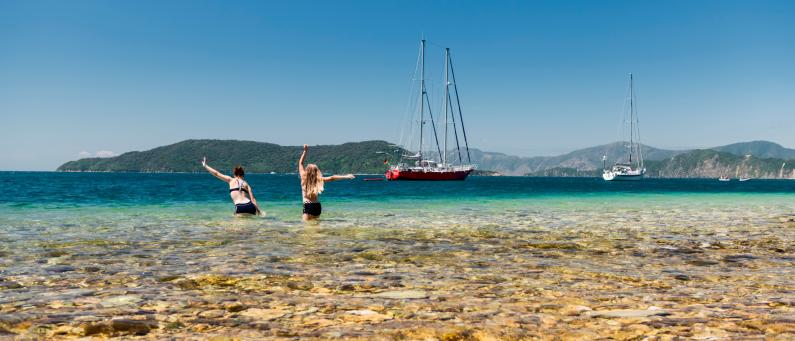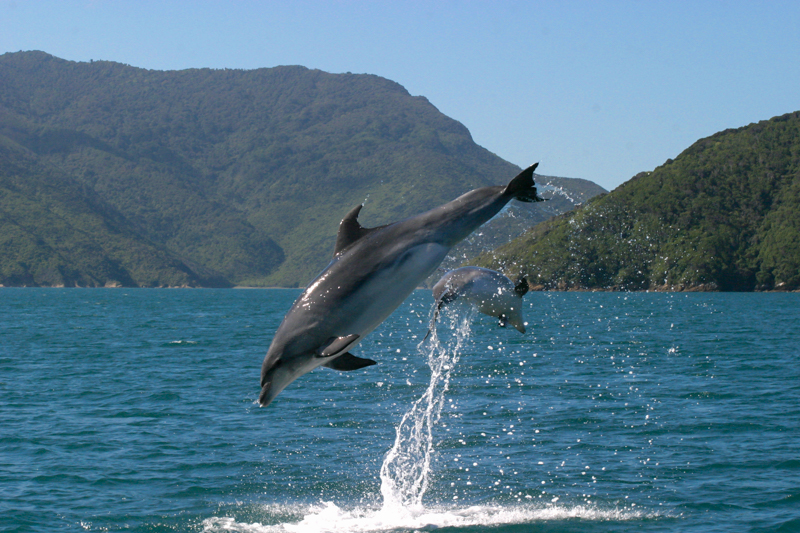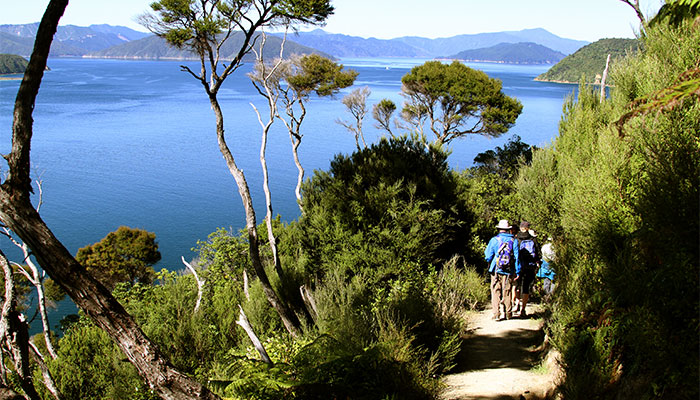THE MARLBOROUGH SOUNDS
In this third blog in a series of my favourite places in New Zealand, I am taking you to the beautiful Marlborough Sounds. It is somewhat baffling to me that so few New Zealanders have visited this part of the country but with a new emphasis on domestic tourism, it is sure to become a destination for many more Kiwis.
Marlborough is not the only area with flooded river valleys in the South Island. Milford Sound is world famous but the staggeringly steep walls of those sounds can be somewhat intimidating and the violent changes in weather add another element to their epic scale. The drama of Milford Sound can be a bit scary when you float through them in a small tourist vessel. On the other hand, the peace and tranquility found in the Marlborough Sounds are inviting and provide a real tonic to the soul. That is why I love this scenic jewel so much.

Man has been afraid to tamper here. Any effort to change the place would be doomed to failure as nature has created the perfect blend of forest, water and hills. To scar it with concrete hotels and apartment blocks would be a sacrilege. The outrageously translucent turquoise water lightly massages the soft sparkling sand as it moves languidly back and forth. I stand in a sort of hypnotic reverie as I listen to the gentle ‘swish’ of each small wave before it dissolves into the sand. My heart flutters when the sound of a bellbird, mimicking an angel singing, is carried on the still air. I’m distracted by a disturbance on the water’s surface a few feet away. I turn and smile at a dolphin as he pops his head up to see me. I now inhale the sweet scent of the dense bush. I hold my breath while the aroma invigorates my senses. I look up transfixed, staring at the sky. I marvel at the red streaks merging with the deep blue of space. I feel in harmony with everything as the sun retires for another day in this place of wonder and magic. I’m left in a silence that speaks to the deepest part of me. I love being here.
When the great English explorer and navigator, James Cook sailed into the beauty of a tranquil bay at the northern tip of New Zealand’s South Island in 1770, his description of the place suggested he’d reached Paradise. Shortly after dropping anchor in the calm, clear water of the small bay, his ship was surrounded by curious dolphins and penguins. His crew feasted on a staggering variety of fish that abounded there. Cook revisited this magic retreat five times until his last visit in 1777. Astonishing as it may seem, Ship Cove hasn’t changed to this day. Only the sleek yachts that visit indicate the passage of time.

The Marlborough Sound is part of a network of drowned valleys containing 4000km of sounds, islands and peninsulas. This part of New Zealand weaves the same magic on the modern day visitor as it did on James Cook, with the sheer beauty of its gently rising, wooded hills and small quiet bays. It’s a sparsely populated area with many of the isolated houses only accessible by boat. This truly is an unspoiled destination waiting to be discovered by more Kiwis.
PICTON
It’s a clear, sunny day with the odd cloud standing out with digital clarity against the deep blue only seen in skies this far south. I amble along the main street of Picton, the main port in the area. The salty tang in the air mingles with the freshness of the air itself. It makes me feel alive and content. This little town has a population of 4,400 and lies at the head of Queen Charlotte Sound. It was created by European sealers in the 1840s, and is the terminus for the South Island’s main railway and road systems. It is also the port for the inter island ferry. (It’s a three hour voyage across Cook Strait to Wellington). I watch the Kaitaki, the largest of the five ships currently on the inter island service, as its white bulk glides up to the terminal. I don’t stop to see the 600 cars and 1,200 passengers disembark. I prefer to remain in the moment and to savour the special atmosphere this part of New Zealand offers. Most of the traffic from the ship will head south to explore the world famous scenic attractions the South Island has to offer. I can’t understand why the Marlborough Sounds, are not part of this tourist circuit. It might be something to do with New Zealanders being spoilt with the number of scenic places they can visit.
AROUND THE SOUNDS
I hop into a car and drive the short distance around to Kenepuru Sound. There are only a handful of cars on the road along the finger of land separating it from Queen Charlotte Sound. I stop at a lookout and gaze across the sparkling water to the densely wooded peninsula that separates me from Pelorus Sound, the third waterway in the Marlborough Sounds. There are so many shades of green in the trees and so many beautiful shades of blue in the sea.
Fur seals are common in this network of bays, and it’s also possible to see magnificent orca whales. Here in these sheltered waterways, pods of dusky, bottlenose and occasionally, the rare Hectors dolphins accompany the small number of boats that use the sounds for recreation. Groupings of these amazing sea creatures can consist of as many as 500. To be in the company of these friendly mammals is to experience one of the true delights of being a human lucky enough to visit this nature’s playground.

FAMOUS DOLPHIN
Pelorus Jack was a dolphin who made this area his home. In 1904, he became the first ‘fish’ in the world to be protected by law. This remarkable dolphin became famous as a ‘guide’ in French Pass, an unpredictable stretch of water at the approaches to the Marlborough Sounds. He escorted ships through these treacherous waters from 1888 until he disappeared in April 1912. He was fond of steamers, and crews would wait for him to appear before sailing through the pass. His loss caused an outpouring of grief throughout New Zealand. I can remember as a kid, having a picture book with drawings of this little dolphin enjoying the attention swimmers gave him. I didn’t believe the story was true. How could a ‘fish’ do all those amazing things? (I have written an earlier blog on Pelorus Jack)
Only 400 people live in Havelock, the other settlement in the Marlborough Sounds. It’s known as the Greenshell Mussel Capital of the world, but a better claim to fame is surely that Lord Rutherford, the man who helped split the atom, opening up the nuclear age, and Dr. William Pickering, the developer of the first American satellite, both went to school in this tiny fishing settlement. Wandering around its peaceful streets is like being on a film set. All that’s needed is for the film crew to arrive and create some action.
HIKING WONDERLAND
It’s not only the waterways that make this place so special. The award winning Queen Charlotte Track winds its way through 12km of beautiful native forest. It was created by European pioneers in the mid1800s as a bridal track and is named after the wife of King George the Third. I’m sure she would be humbled to know such a magical place carried her name. I amble along the narrow walkway, peering into the thick bush either side of me. I pause to watch a sparkling drop of water make its way to the very tip of a superbly intricate frond of the native fern. I fail to understand why this exquisite symbol of nature’s craftwork, is not on the New Zealand flag, but I’m pleased to see it now appears prominently on many of Air New Zealand’s larger planes. As I watch this delicate tiny marble of water plop onto a pebble below, I smile to myself. I’m a character in a kid’s fantasy story. Nearby, I hear a light rustling and turn to see a cheeky little fantail flip open its beautiful tail in excitement. Further along the track a friendly bush robin hops close behind me. He pecks at my last footprint. I’ve disturbed a grub. I’m pleased to be able to help him find food so easily. He keeps me company and reminds me how special this place is.

I stop for dinner at the Portage Hotel. It has been located in a small bay in Kenepuru Sound for a hundred years. This hotel is accessible by road and motorists driving along it are rewarded with postcard perfect views around every corner. The view up the sound from the hotel is claimed to be one of the most memorable views from any hotel in the world. It has to be seen to be appreciated. The isolation, stillness and natural beauty, all work to touch my heart. I’m at peace with the world. I feel strangely free. There’s also something wonderful about the quality of the light here. The colours are intense. Everything seems so vivid. Sounds seem to be amplified. The flutter of a bird in the near distance is as clear as the trickle of a baby stream a few feet away. The leaves in the trees, disturbed by a light breeze, have a crispness to their rustling. Everything seems to be, well, sort of unreal, sort of magical. I’m that character in a kid’s fantasy story again, in a fantastic place, far, far away from my ordinary world.

This magical place, only fifteen minutes by air from the capital of a country with such a highly developed tourist industry, is blessedly under commercialized. There are no fast food outlets, billboards, traffic lights, or convoys of tour buses to taint this scenic gem. The magic remains as nature has designed it. The visitor can only marvel at the pristine beauty of a place that helps the soul soar and the mind rest and ponder.
Ceidrik Heward
Ceidrik Heward is an Amazon TOP SELLING AUTHOR and has lived and worked in 7 countries working as a TV cameraman, director and film tutor. For the past 17 years he has focused on writing and has been published in magazines and newspapers in Europe, USA, Asia and the Middle East.
His interests include photography, psychology and metaphysics. He loves to read and always has at least 3 books on the go. He has written 22 manuals/books and has just completed his 4th short novel. Ceidrik believes sharing information and stories is the best way to stimulate the imagination and enrich our lives.




















 Visit Today : 768
Visit Today : 768 Total Visit : 1078383
Total Visit : 1078383
Speak Your Mind